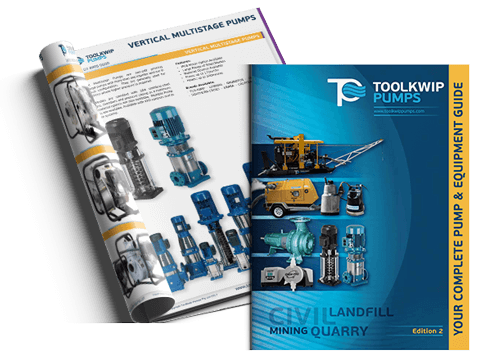Maximum Pump Efficiency Delivered by Toolkwip’s Self-Priming Pumps
In a centrifugal pump, the chambers must have water to create a pressure differential around the impeller to cause the pumping process to start. Trapped air in a centrifugal pump separates from the water and causes it to become air-bound. The pump cannot push-out the air and becomes less efficient at pumping water; if too much air is present then the pump stops working as it cannot force the water out centrifugally. The priming process adds time, and if not done properly can lead to lost efficiency and the wearing out of parts. Self-priming pumps provide a solution to this problem.
The Self-Priming Process
Self-priming centrifugal pumps overcome the need to manually prime the pump with water before starting. The pump still requires water to operate; however, it is able to resolve the problem of air binding by mixing the air and water together. The mixture is expelled by the impeller into a chamber where the air and liquid separate; the air is discharged and the water falls back to the impeller and mixed with incoming liquid and air. It is ejected again into the chamber and separated from the air. The process continues until all the air is discharged and only the liquid is in the pump.
Recirculation and Diffuser
To achieve a successful transfer of the liquid-air mixture, pump designers use two common schemes: recirculation priming and diffuser priming.
The former – recirculation priming – is a method that uses a check valve located between the suction passageway and a liquid reservoir that holds the water. The presence of air in the suction passageway automatically opens the check valve to allow liquid from the reservoir to recirculate through the impeller.
Diffuser priming was designed to resolve some issues brought by recirculation and avoids the valve needed for recirculation priming. The air and water are mixed, but kept at the outer edge of the impeller so the impeller remains only submerged in liquid. This mechanism is more efficient, with the air expelled through diffuser vanes around the circumference.
Advantages of Self-Priming Pumps
Given these features, self-priming pumps have the upper hand over non-self priming centrifugal pumps when it comes to handling fluids. Self-priming pumps perform well even in the presence of slurries, corrosive substances and solids.
The ability of self-priming pumps to handle solids is one of its main advantages. With a solid handling capacity of over three inches, clogging and other problems happen less often. Self-priming pumps normally have low net positive suction head requirements, which make them ideal for boiler feeds.
Australia’s Leading Self-Priming Manufacturers
Toolkwip Pumps is a trusted self-priming pump manufacturer in Australia, providing turnkey solutions for all your auto-priming needs. We are also authorised distributors for international brands like Selwood Pumps.
Our own FLO-KWIP Auto-Priming Pumps are fitted with a diaphragm-type priming system that delivers a quick and efficient priming process. Our standard range of pumps comes in three varieties – dewatering, high head and solids handling. Each category presents water tolerant properties that give years of service and long-term use.
Browse through our catalogue and contact us today for any enquiries. Call us on +61 3 8805 0500 to reach our head office.
